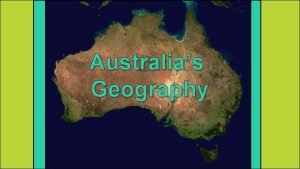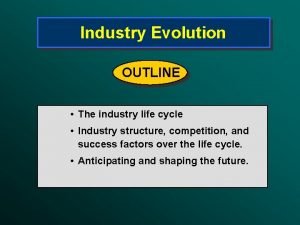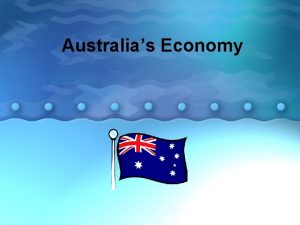Australian Economy Yahan Tao985821 Australian retail Industry Australias







- Slides: 7

Australian Economy Yahan Tao(985821)

Australian retail Industry Australia‘s retail industry is struggling in July, with the 0. 1 per cent(Australian Bureau of Statistics) The retail sales of four industries including clothing, department stores, catering and other retailing all fell. Restaurant service which led the falls fell by 0. 6 percent. The fall in department stores is only 0. 2, which is the least (ABS) Retail sales in six regions, including South Australia, Queensland, also have experienced varying degrees of decline. South Australia and the Australian Capital Territory led the fall(-0. 5 percent). But New South Wales, Tasmania and Victoria only fell by 0. 1 percent. (ABS) Retail sales growth slowed in July 2019 compared with the 0. 2 percent rise in June. Online retail turnover contributed 6. 1 percent to total retail turnover in July 2019, which showed no improvement compared with that in June “It’s a struggle, you’ve got a very unusual situation where the private part of the economy is actually going backwards. ” National Australia Bank chief economist Alan Oster said of the figures. Household finances are under pressure and consumers are more reluctant to spend money as they did in the past. Deloitte Access Economics partner and Retail Forecasts principal author, David Rumbens, said: “March quarter retail data confirmed our view that consumers are just not willing to spend as they once were. People are pulling back on spending as household finances remain under pressure from stagnant wage growth and declining wealth. The condition of retail industry are likely to improve significantly in the second half, thanks a lot to monetary and fiscal stimulus measures such as tax-cutting. “While the first half of 2019 is constrained by weak income growth, the latter half will likely receive a boost as monetary and fiscal stimulus work together for the first time in over a decade. ”(David Rumbens)

The Speech- Guy Debelle The trade war between China and the United States brings uncertainty: one is about the size and scope of the tariffs, and the other is about whether the technical disputes will be resolved. Australia’s terms of trade are at the highest level since 2013, more than 10 percent higher than economists think. This is because Australia isn’t heavily involved in the global supply chain and mainly exports resources. In addition, Australia’s economy is mainly affected by China‘s domestic economy. “To date, the Australian economy has been largely shielded from the effect of the trade disputes. ” “While the Australian economy is often regarded as a proxy for China, the primary exposure of the Australian economy is to the Chinese domestic economy, not the Chinese external sector. The external sector has been the part of the Chinese economy most affected by the trade dispute. ”(Guy Debelle) “The domestic stimulus in China to offset the trade dispute has contributed to a short-term boost to the Australian economy and significantly mitigated the impact of the trade disputes on us. ” The outlook for consumption is a major risk to the Australian economy. “But the September quarter national accounts recorded both a notably slower pace of consumption growth in that quarter, and a downward revision to the recent history. ” For years, disposable household income grew slowly while tax revenues rose rapidly. Due to recent tax cuts, real estate market recovery and other progress, future consumption prospects will be more stable

Australia’s future economic plans --speech by Josh The goal: a stronger and more competitive economy; Restore the country’s finances “As we climb the Frydenberg mountain and reach our goal of eliminating Commonwealth net debt by 2030 or sooner. ” Reduce debt and interest rates through responsible budget management and economic growth, not by raising taxes. “over the last year the interest bill on the national debt was $18 billion. This is money that could have built 500 schools or a world-class hospital in each state and territory. ” Deliver tax relief: cut income taxes by $158 billion and reduce the tax rate to 30%. “This tax relief will lift household incomes, ease cost of living pressures and boost spending at local businesses. ” Backing small business: the tax rate on small businesses will be reduced to 25%, and $2 billion in new funds are being used to increase their financing channels. “Small businesses are the engine-room of our economy. They are integral to every local community. ” Investing in infrastructure: infrastructure spending will be raised to $100 billion over the next 10 years, and the urban congestion fund will be increased to $4 billion from $1 billion. “To ease congestion in our cities. To unlock the potential of our regions. To better manage population growth. To improve safety on our roads. ” Investing in skills: Add 80000 apprenticeships in technology-strapped industries; Improve Australians’ literacy and numeracy skills. “Our people are our most valuable asset. ” Investing in young people: Granting $453 million to expand preschool education; Set up a school community project to upgrade libraries and classrooms. “Education is the first defence of the nation. ”

Australia’s GDP • • Australia's economy has slowed further, with GDP growth falling below 2 percent over last year. Australia's economy has slowed to its most sluggish pace since 2009 It is the fourth consecutive quarter of weak GDP growth, dragged down in particular by sluggish growth in household spending. Australian economic growth over the first half of this year has been lower than previous expected. “The figures showed the fundamentals of the Australian economy were strong. Today's national accounts show the Australian economy continues to grow in the face of significant headwinds, both international and domestic. "(Treasurer Josh Frydenberg) JP Morgan chief economist Sally Auld thinks the economy won’t improve dramatically in the next few years. “That would require a significant drop in the unemployment rate and a big increase in wages, which are both unlikely to happen. ” “A recession is never desirable, but it would ultimately put the Australian economy back into a position where stronger growth was possible. ” (Sally Auld) Public demand contributes the most to GDP, thanks to higher spending in disability, health and aged care services.

Australia’s housing price After two years of decline, the housing market is starting to pick up in July 2019, housing prices rose in all capital cities except Adelaide, Perth and Canberra. The stabilization in housing values is becoming more broadly based, with five of the eight capital cities reporting small rises in prices over the past month, while areas such as south Australia, Tasmania and the northern territory also saw a lift in housing price. The rebound in the housing market can be attributed to the following factors: The RBA’s back-to-back interest rate cuts, which have pushed mortgage rates to record lows, and the prospect of further falls to come; Because of tax cuts, we have more money in our pockets; The APRA’s loosening of mortgage stress tests “After two years of declines, some stability looks ahead for house prices. ” economists Felicity Emmett and Adelaide Timbrell said. "Our view is that dwelling price rises may materialise from the second half of the year as demand increases as a result of the expected improvement in confidence, " SQM's Louis Christopher said. BIS Oxford Economics predict that house prices in Sydney will rise by only 6% between now and 2022, still leaving prices 13 percent below their previous peak. Its forecast for Melbourne is similar, with a 7 percent rise and prices remaining 10 percent lower than the peak three years later. ANZ expects housing prices to bottom and rise only modestly this year before rising by 3 percent nationally next year, with Melbourne expected to see bigger increases than Sydney.

Reference 1. Letts, S 2019, Australia's economy has slowed to a decade low but the budget may already be back to surplus, viewed 14 th September 2019, <https: //www. abc. net. au/news/2019 -09 -04/gdp-q 2 -2019/11474470>. 2. Taylor, D 2019, Australian economy set for weakest GDP growth in nearly 20 years, viewed 14 th September 2019, <https: //www. abc. net. au/news/2019 -09 -04/gdp-growth-set-for-weakest-result-in-nearly-20 years/11475438 >. 3. Janda, M 2019, House price falls may be ending, but do not expect another boom, viewed 14 th September 2019, <https: //www. abc. net. au/news/2019 -07 -19/house-price-falls-are-ending-but-dont-expect-anotherboom/11298992>. 4. Jardney, M 2019, State by state: An August update on Australia’s property markets, viewed 14 th September 2019, <https: //www. smartcompany. com. au/industries/property/august-australia-property-markets/>. 5. Australian Bureau of statistics 2019, Retail turnover falls 0. 1 per cent in July, viewed 14 th September 2019, <https: //www. abs. gov. au/ausstats/abs%40. nsf/mediareleasesby. Catalogue/79 EACA 2718 D 0318 ACA 2581 AF 001493 AA? Open. Document>. 6. Debelle G 2019, Risks to the outlook, viewed 14 th September 2019, <https: //www. abs. gov. au/ausstats/abs%40. nsf/mediareleasesby. Catalogue/79 EACA 2718 D 0318 ACA 2581 AF 001493 AA? Open. Document>. 7. Frydenberg J 2019, Budget speech, viewed 14 th September 2019, <https: //ministers. treasury. gov. au/ministers/josh-frydenberg-2018/speeches/budget-speech-2019 -20>. 8. RESERVE BANK OF AUSTRALIA 2019, The Australian Economy and Financial Markets, viewed 14 th September 2019, <https: //www. rba. gov. au/chart-pack/pdf/chart-pack. pdf? v=2019 -09 -15 -09 -34 -44 >.












